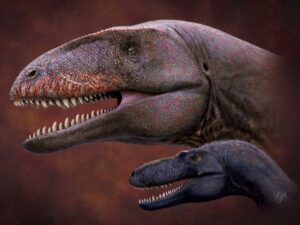Can Dinosaurs Jump
While the colossal size of dinosaurs often paints them as earthbound giants, the question of their ability to jump juxtaposes our perceptions with the mechanics of their anatomy.
Experts have scoured fossil records, piecing together a narrative that challenges long-standing assumptions. They've analyzed the leg bone structures, muscle attachments, and even footprints left behind in ancient mud.
The findings suggest a nuanced reality, with variances across species that could reshape our understanding of these prehistoric creatures. As we stand on the brink of these revelations, one can't help but ponder the implications of such abilities, inviting further exploration into a realm where science meets imagination.
Key Takeaways
- Small theropods had strong hind limbs, indicating a capability for powerful jumps.
- Large sauropods' weight likely limited their ability to jump due to prioritizing support over agility.
- Jumping abilities among dinosaurs varied greatly, reflecting their diverse ecological niches and locomotion strategies.
- The feasibility of jumping in dinosaurs can be assessed through their anatomy and biomechanics, including limb leverage and muscle strength.
Understanding Dinosaur Anatomy
To accurately assess the jumping capabilities of dinosaurs, it's essential to first delve into their complex anatomical structures, focusing on their skeletal framework, musculature, and biomechanical attributes. Dinosaurs, a diverse group of reptiles, showcased a wide array of anatomical adaptations that suggest varied levels of mobility and strength.
The skeletal structure, particularly the configuration of the pelvic and hind limb bones, played a pivotal role in determining a dinosaur's potential for generating the force needed for jumping. Musculature, especially the development of strong, elastic muscles attached to these skeletal elements, further influenced their ability to leap. Biomechanical attributes, including the leverage and mechanical advantage offered by the arrangement of bones and muscles, were critical in facilitating or limiting their jumping capabilities.
Understanding these anatomical nuances provides a foundational basis for exploring the physical feasibility of dinosaurs performing such dynamic movements.
The Science of Jumping
Having established the anatomical framework of dinosaurs, it's now crucial to explore the biomechanics of jumping, focusing on the forces and movements required to propel an organism off the ground.
Jumping, a dynamic locomotor activity, involves rapidly generating force through muscular contractions, which translates to the ground through the limbs, overcoming gravitational pull. This action demands a significant energy output and an efficient musculoskeletal system capable of storing and releasing energy.
For dinosaurs, whose sizes and body structures varied immensely, the capacity to jump would hinge on their ability to generate sufficient force relative to their body mass. Additionally, the mechanics of jumping would be influenced by the leverage provided by their limbs, the strength and elasticity of their muscles, and their overall body balance and coordination.
Fossil Evidence and Insights
While analyzing the biomechanics of jumping in dinosaurs, researchers turn to fossil evidence to glean insights into their physical capabilities and limitations. By meticulously examining the structure of leg bones and comparing them to modern jumping animals, scientists can infer the potential for such actions in ancient creatures.
Fossilized footprints also offer clues, showing the spacing and depth of prints that might indicate a jumping motion. The orientation and articulation of hip and leg bones in skeletal remains further contribute to understanding the mechanics of potential jumping behavior.
This careful scrutiny reveals not just the possibility of jumping, but also the probable efficiency and effectiveness of such movements, providing a nuanced view of these ancient animals' locomotion.
Variations Among Species
Dinosaurs exhibited a wide array of jumping capabilities, reflecting the diverse anatomical adaptations among different species. Small, bipedal theropods, for example, possessed strong hind limbs with elongated femurs and well-developed caudofemoral muscles, suggesting they could have executed powerful jumps to catch prey or evade predators.
Contrastingly, the massive, quadrupedal sauropods displayed skeletal structures that prioritized weight support over agility, indicating jumping was likely beyond their physical capabilities. Similarly, ornithischian dinosaurs, with their varied body sizes and limb proportions, showed a spectrum of potential jumping abilities, from the agile hadrosaurs to the heavily armored ankylosaurs, whose body plans suggest minimal to no jumping capacity.
This variation underscores the complexity of dinosaur locomotion and the influence of ecological niches on their evolutionary adaptations.
Implications of Jumping Abilities
The diversity in jumping capabilities among dinosaur species offers insights into their predatory and defensive behaviors within various ecological contexts. Predators with notable jumping abilities likely possessed an evolutionary advantage, enabling them to ambush prey with swift, unexpected leaps. This trait suggests a high degree of agility and muscular strength, characteristics vital for both hunting and evading threats.
Conversely, herbivorous dinosaurs that developed jumping skills may have used these abilities primarily for defense, evading predators through quick, agile movements. Moreover, the ability to jump could have facilitated access to resources, such as food and mates, influencing social and mating behaviors.
Understanding these dynamics sheds light on the complex interplay between physical capabilities and survival strategies, highlighting the adaptive nature of dinosaur species within their environments.
Conclusion
In conclusion, the intricate study of dinosaur anatomy, combined with the principles of the science of jumping, offers fascinating insights into these ancient creatures' capabilities. Fossil evidence and variations among species suggest some dinosaurs may indeed have had the ability to jump.
But, one might wonder, how did these massive creatures manage such feats? Understanding their jumping abilities not only enriches our knowledge of dinosaur behavior but also enhances our appreciation for the complexity of life on ancient Earth.




